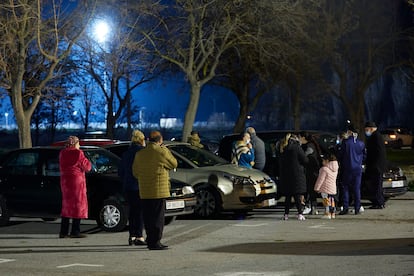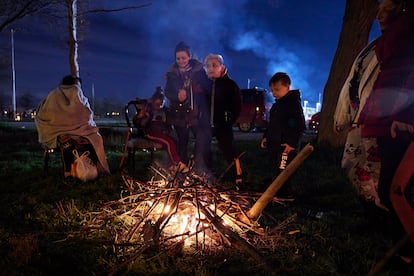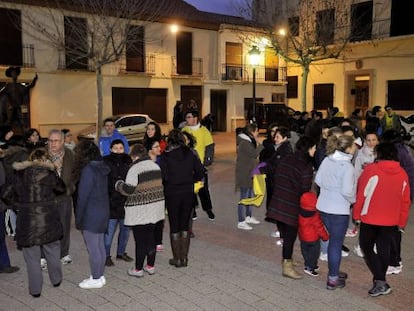Granada province hit by nearly 50 earthquakes, the largest 4.3 on Richter scale
The tremors have caused widespread alarm among local communities, with some families opting to sleep in their cars in open spaces due to fears of staying in their homes

Granada province, in southern Spain, was hit on Thursday by 49 earthquakes, according to the National Geographic Institute (IGN). The largest of these, with a magnitude of 4.3 on the Richter scale, struck at 7.49pm at a depth of three kilometers. The city of Granada and its metropolitan area had already been shaken by 42 tremors of varying magnitudes before the latest ones were felt.
Local police in the municipality of Santa Fe, the epicenter of the 4.3-magnitude quake, said that one building had suffered minor damage, but did not pose any risk. Officers did, however, warn citizens to take care when passing by certain areas of the city center, which are home to a large number of old buildings.
If an earthquake doesn’t kill me, a heart attack willJuan Fernando Martínez, local resident
The earthquakes on Thursday are the latest in a series to hit the southern province, located in the Andalusia region. Twelve tremors – two with registered magnitudes of 4.4 and 4.1 on the Richter scale – struck Granada province on Tuesday. And between Saturday and Thursday, more than 500 earthquakes have been recorded near the municipalities of Atarfe and Santa Fe, according to IGN. Of this number, 13 had a magnitude over 3 on the Richter scale and four measured over 4.
The surge in seismic activity has sparked alarm in the local community. After the earthquakes on Tuesday, many residents fled to the streets, despite the coronavirus curfew. The tremors have also caused minor damage to the Alhambra, the world-famous palace complex in Granada, and forced some schools to close.
But the biggest impact has been the pervading sense of fear, which has prompted some residents to leave the city for the coast. Christian Muñoz, a professor at the University of Granada who is a specialist in urban mobility, has been analyzing vehicle traffic in the days after strong earthquakes. He detected that the number of cars leaving in the direction of the coast multiplied ninefold on Tuesday, following the series of earthquakes. Data from 8pm on Thursday – just after the 4.3-magnitude tremor struck – also showed a spike in traffic in that direction.

Other residents have been sleeping in their cars in open spaces. Since Tuesday, Juan Fernando Martínez, a 52-year-old waiter, his wife María José, and their 14-year-old daughter, have all been staying overnight in an empty field next to a soccer pitch in Santa Fe. They explained that they are doing this because their daughter is asthmatic and they are scared that the situation will worsen. They arrived just after 7pm on Thursday. María José said she has gone three days without sleep and has only been drinking tea. Juan Fernando said he is desperate: “If an earthquake doesn’t kill me, a heart attack will.” If he was alone, he said, “I would take the car and head for Málaga or wherever, but with the family that’s impossible.”
Since December 1, there have been an estimated 585 earthquakes in the area, of which 15 have measured 3.0 or more on the Richter scale
By 9pm on Thursday, around 20 cars had already arrived in the open field, and more were arriving. It seemed that the people were waiting for another earthquake – after experiencing 49 in one day – and the fear had driven them from their homes.
Local resident Melchor arrived at the field with his wife and two elderly parents. He did not want to spend the night in his home and he was angry with local authorities for not letting him stay in the street. “We are not here because we want to be, we are here because we are very afraid.” He complained that no one has put up a tent where people can have coffee and “eat something.” José Tirado, another resident in the field, said he would have preferred to stay at home, but admits he has problems with anxiety. Manuel Gil, the mayor of Santa Fe, visited the space after 9.30pm on Thursday. He was asked for tents, support from the Civil Protection service and permission to light a fire “because the night is long and very dark,” said Melchor.
Since December 1, there have been an estimated 585 earthquakes in the area, of which 15 have measured 3.0 or more on the Richter scale. A total of 61 have been felt by the population. Experts have blamed the recent seismic activity on the constant approximation, by four to five millimeters each year, of the Eurasian Plate and the African Plate.
The earliest earthquake recorded in Granada took place in the south of the province in 1431 and caused major damage to the Alhambra. The strongest one recorded struck in 1884 in Arenas del Rey and left 839 people dead.
English version by Melissa Kitson.
Tu suscripción se está usando en otro dispositivo
¿Quieres añadir otro usuario a tu suscripción?
Si continúas leyendo en este dispositivo, no se podrá leer en el otro.
FlechaTu suscripción se está usando en otro dispositivo y solo puedes acceder a EL PAÍS desde un dispositivo a la vez.
Si quieres compartir tu cuenta, cambia tu suscripción a la modalidad Premium, así podrás añadir otro usuario. Cada uno accederá con su propia cuenta de email, lo que os permitirá personalizar vuestra experiencia en EL PAÍS.
¿Tienes una suscripción de empresa? Accede aquí para contratar más cuentas.
En el caso de no saber quién está usando tu cuenta, te recomendamos cambiar tu contraseña aquí.
Si decides continuar compartiendo tu cuenta, este mensaje se mostrará en tu dispositivo y en el de la otra persona que está usando tu cuenta de forma indefinida, afectando a tu experiencia de lectura. Puedes consultar aquí los términos y condiciones de la suscripción digital.
More information
Últimas noticias
A survivor’s account of the Interoceanic Train accident: ‘We were scared because of the speed on the curve’
The Interoceanic Train, the Mexican alternative to the Panama Canal
What is known about the Interoceanic Train derailment in Oaxaca
Trump turns a Minnesota fraud allegation into ammunition for his MAGA army against Democrats
Most viewed
- Oona Chaplin: ‘I told James Cameron that I was living in a treehouse and starting a permaculture project with a friend’
- Reinhard Genzel, Nobel laureate in physics: ‘One-minute videos will never give you the truth’
- Why the price of coffee has skyrocketed: from Brazilian plantations to specialty coffee houses
- Pablo Escobar’s hippos: A serious environmental problem, 40 years on
- Chevy Chase, the beloved comedian who was a monster off camera: ‘Not everyone hated him, just the people who’ve worked with him’











































